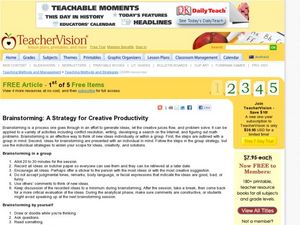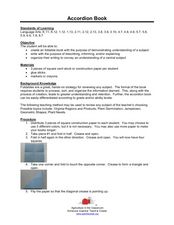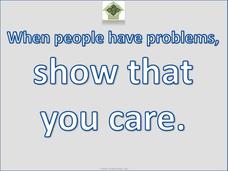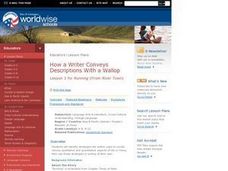Teaching Methods and Strategies Teacher Resources
Hi, What do you want to do?
Find Teaching Methods and Strategies lesson plans and worksheets
Showing 976 resources
Curated OER
Prepositions
After reviewing the different purposes of prepostions and many examples, the class can practice using them in sentences. While little direction is provided in the plan, this is a fantastic resource for teachers looking for a simple...
Curated OER
Brainstorming: A Strategy for Creative Productivity
In this brainstorming activity, students read directions on how to brainstorm with a group or as an individual. Students read 7 tips total.
Curated OER
Reader's Theater
Students study sequencing while reading an Australian folk tale. In this sequencing lesson students read a folk tale using Reader's Theater and discuss what happened first, second and last. Students also create animal ears and noses...
Curated OER
Plan Ahead for Professional Development
You can learn something new this fall and winter by attending a conference or seminar.
Curated OER
Using Process Drama in the Language Arts Classroom
Using the tools of process drama to create authentic learning experiences for students.
Curated OER
A Passage Through Time
Young learners research and present information about a chosen subject to their peers, parents, instructors, and community. This lesson has a strong research and public speaking component, and would be ideal for your higher level students.
Curated OER
The Environment
Students explore the issues that influence our environment and research ways to decrease the negative impact that humans have on the environment. Misconceptions about environmental issues are addressed in this lesson.
Curated OER
Children of War
Take a closer look at the impact of war in this language arts and social studies lesson. Middle schoolers use primary sources to conduct research as they relate to the effects of war on children. They compare and contrast the effects of...
Curated OER
Character in a Box
Partners choose, research, and analyze fictional or historical characters and design character life boxes to represent them. They also compose a rhyme royal, which they understand inductively by deconstructing examples. Based largely on...
Curated OER
A Listening Doll: Create Traditional Native American Storyteller Dolls
In this wonderful cross-curricular lesson, your youngsters will learn about Pueblo Indian storyteller dolls by creating their own! They discuss the tradition of story telling, especially in reference to Native Americans. Consider ending...
Curated OER
How Do Artists Effectively Relate Historic Events?
Students explore African American migration. In this black culture and history lesson, students use a map to identify northern and southern states in which African Americans lived in the 1900s. Students observe and describe objects and...
Curated OER
Map It Out
Explore how illustrations add to a story. Young learners will look at picture books to see how the pictures tell the story. They create illustrations to go with a chosen story, and then flip the activity so they have to write a story to...
Curated OER
Accordion Book
Students make an accordion book to show information that is associated with a particular learning event. In this accordion book lesson, students follow paper-folding directions to make the book. They fill the book with key facts and...
Curated OER
Relations and Graphs
Here is a simple, yet clever lesson on how to teach the important concepts of greater than, less than, and equal to. Pupils write their names down on grid paper - one letter per box. They compare their names and find a name that is...
Curated OER
Reading a Comparison-Contrast Essay
Turn your passive readers into active readers with an engaging lesson on reading informational text. Focused on compare and contrast structured essays, the activity prompts elementary learners to jot down questions and think-aloud...
Oxford Cambridge
Set and Prop Design
What's the difference between set dressing and a prop? Between a costume accessory and a personal prop? As part of their study of set and prop design, class members engage in a series of activities that prepare them to design a prop for...
Curated OER
Reliving History through Slave Narratives
Helpful for an American literature or history unit, this lesson prompts middle schoolers to examine slavery in the United States. They read slave narratives that were part of the Federal Writers' Project and then conduct their own...
Curated OER
Show That You Care
Learners on the autism spectrum can have difficulty expressing care or providing emotional support for others. Support them with this series of presentation slides that break down the steps to showing others you care, from appropriate...
Curated OER
How a Writer Conveys Descriptions With a Wallop Lesson 3 for Running (From River Town)
Young scholars examine strategies an author uses to provide qualitative and quantitative aspects of life in China. They apply the strategies to their own writing.
UNICEF
Knowing Your Risk for HIV/AIDS
What are the various ways people can become infected with HIV? Build awareness with your pupils and dispel common myths on the transmission of HIV with this resource, which includes a brainstorming activity, group discussion,...
Curated OER
Role Models
First graders identify heroes by researching their family history. In this personal heritage lesson, 1st graders define the term "hero" and the characteristics that represent it. Students research family resources and family trees in...
Maine Content Literacy Project
Introduction to Ernest Hemingway
What is a white elephant, and what does it have to do with Ernest Hemingway? Study "Hills Like White Elephants" in-depth by following the procedures outlined in this instructional activity, the fifth in a series of fourteen. Learners...
Brooklyn College
Irony, Sarcasm, Satire
Irony, the discrepancy between what is expected and what occurs, is the focus of a reference sheet that provides young writers with models of this literary device.
Curated OER
Growing a Nation
Eleventh graders examine the Dust Bowl in American History. In this US History lesson, 11th graders read a transcript on the Dust Bowl. Students analyze a video on the Dust Bowl.























